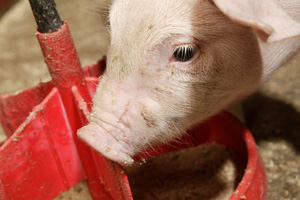Sodium butyrate in piglet feed reduces diarrhoea

One of the benefits of adding sodium butyrate in the feed of piglets is the reduction of post weaning diarrhoea, which is one of the most frequent explanations for the morbidity and mortality observed at this age.
In a recent paper (J. Anim. Sci. 2012), Ma et al. tried to understand by which mechanism sodium butyrate can decrease the incidence of diarrhoea. In an in-vitro experiment, cultured cells were scratched to induce wound, then were treated with sodium butyrate. The publication shows that addition of sodium butyrate accelerated the process of wound healing, confirming a protecting effect of butyrate on the intestinal mucosa. When compared to a control group, the authors observed that mRNA expression of the intestinal mucosal tight junction proteins occludin and zonula occluden protein-1 was increased.
Besides, in the butyrate-treated cells, the levels of superoxide dismutase and glutathione peroxidase, two of the main antioxidant enzymes, as well as glutathione, one of the nonenzymatic antioxidant components, were significantly higher than in the control group. Also, malondialdehyde, a marker of free radical mediated lipid peroxidation injury, was present at lower levels in the cells treated with sodium butyrate. These results confirm previous research suggesting that one of the benefits of sodium butyrate in the intestine is to maintain the function of the intestinal barrier.
Together with the report of Peng et al. (2009), this study also indicates that adding sodium butyrate in feed can probably play an important role in maintaining the intestinal tight junctions, which are essential to preserve the gut integrity.
Source: Norel











